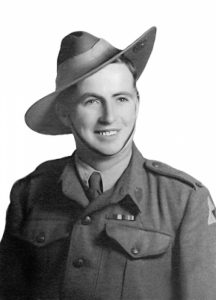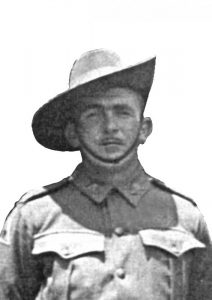
The following Bassendean Boys with 2/4th were compiled by C. Mellor – please be aware their names are not included above, except W. Worth (however we cannot confirm this is WX10012 Walter Worth)
Three mates who had grown up at Bassendean included Roy Maconachie, Archie McIntosh and ‘Tiny’ Lear – did not return home.
Maconachie and McIntosh were in HQ Coy, No. 1 Platoon, Signals as was Walter Worth. Worth, McIntosh and Holding worked on Burma-Thai Railway with ‘F’ Force. Lear and Maconachie left Singapore to work in Sandakan, North Borneo and died there during1945.
Holding and Lear were with ‘E’ Company, SRB.
MACONACHIE, Roy David WX9801 b. Dundee Scotland.
Arrived WA with his family, settled Bassendean. Enlisted 6 Dec 1940. Trained as Signaller, HQ Company.
As POW at Singapore Maconachie sailed to Borneo with ‘B’ Force. Their task was to construct an airfield for Japanese military at Sandakan.
Roy died (acute enteritis according Japanese records) 5 June 1945, 26 miles from Sandakan on Sandakan-Ranau track with Second March. He was one of at least 113 Australian POWs who died during the first 8 days of 2nd March which had left Sandakan 28 May. They started as 536 POWs, leaving behind 288 sick men at Sandakan.

Second March began Sandakan 29 May 1945. 536 mostly sick POWs set out in groups of about 50 men with Japanese and Formosan guards. They each carried about 20 kg load on their backs made up of ammunition, rice, supplies and soldiers personal packs.
The track was no ordinary track. It was wet season. The jungle track was muddy and arduous with hills, mountains, rivers & creeks to cross. Provided little food, the starving and ill POWs were prodded by their captors with boots, rifle butts and bayonets. The last group on the March included ‘the death squad’ – their instruction was to dispose of any lingering and sick men. Gunshots could be heard by the last groups.
Only 183 survivors of 2nd March arrived Ranau. They found just 6 men alive from 1st March (455 POWs initially set out from Sandakan beginning 28 Jan 1945).
Growing up in Bassendean Roy’s family were close friends of another Scottish migrant family – the McIntoshs. The friendship continued with son Archie McIntosh WX9849 b. Scotland 1920 also enlisting 6 Dec 1940, joining 2/4th as Signaller with HQ Company.

Archie went by train to Burma-Thai Railway with ‘F’ Force. Wally Holding also worked on Burma-Thai Railway with ‘F’ force. He died 10 Nov 1943 of beri beri and dysentery aged 23 years at Tanbaya Hospital Camp, Thailand.
Please read further about ‘F’ Force Thailand.
And about Tanbaya Hospital Camp run by Dr. Bruce Hunt
Harold Bernard ‘Tiny’ Lear WX7043 b. Midland Junction 1919 was close mates with Maconachie and McIntosh having grown up in Bassendean. Lear sailed from Singapore with ‘E’ Force to Borneo in 1943. Although ‘B’ and ‘E’ Forces were at Sandakan No. 1 and No. 3 – communication was forbidden and punishable. Lear and Maconachie would have been aware of each other’s presence at Sandakan. The Australians communicated by various means. Towards the last year the two Camps were combined.
All Australians were combined at Sandakan No. 1 Camp on 17 Oct 1943.
After 1st March departed 28 Jan 1945 and before Roy Maconachie left Sandakan with 2nd March beginning 29 May, ‘Tiny’ Lear d. malaria 17 March 1945 aged 25 years at Sandakan No. 1 Camp and was buried here. He was married.

About 2,000 Australian and British POWs were sent to Sandakan, Borneo in two parties from Singapore in mid 1942 and early 1943 to build an aerodrome for Japanese military. By end of 1944 the aerodrome was completed, then successfully bombed beyond use by Allies.
From beginning 1945 the Japanese systematically and deliberately starved the POWs. They issued no further rice or provisions. Forbade POWs from trading with locals. The POWs survived on small amounts of rice they had managed to store over time.
The only survivors were 6 Australians who escaped and miraculously survived with the daring assistance of the local population. It was because of these men we have knowledge of what took place in the last months of the war, Sandakan to Ranau.
WX14495 William George Raymond STUART (Bill) from Bassendean KIA 9 Feb 1942 at 14 Mile Peg, Lim Chu Kang Road, Singapore aged 49 years. Stuart was coming out from west coast of Singapore when his group were split up under enemy small arms fire. He was never seen again.
Stuart was WW1 veteran. Wounded Gallipoli with 16th Battalion & again at Hill 63 Messines Ridge. He was awarded Military Medal for his actions at Proyart with 48th Battalion in 1918. You can read further about Proyart.
https://www.awm.gov.au/collection/PL2472
He was Staff Sergeant & Vickers machine gun instructor with 16th Battalion militia prior to enlisting AIF 23 June 1941.
WX10012 WORTH, Walter George b. 5 Apr 1912 Guildford to De Courcey Cleaver and Olive Ernestine Worth. Worth d. Sonkurai Camp Thailand 28 Aug 1943, was 35 years old. He was a signaller with Headquarters Company.
He left Singapore with ‘F’ Force, (member of both Colonel Kappe’s and Pond’s parties) – his is the only name to be found inscribed on the above Memorial.
He resided at Bellevue with his wife.

Above: There were regular notices in newspapers throughout the war years from the Bassendean Circle 2/4th women. We have yet to identify the group, however believe several may have suffered the death of their sons.
____________
HOLDING, WALTER ‘WALLY’ WX17634 b. 1919 Bassendean enlisted 12 Nov 1941 joined 2/4th as reinforcement with ‘E’ Coy.
Wally was selected in Singapore to work on Burma-Thai Railway with ‘F’ Force as was Archie McIntosh. Bassendean boy Holding knew Maconachie and Lear.
Wally survived the railway to return to Singapore at end of 1943.
After the war Wally wrote:
‘It turned out that two of the boys we knew at Bassendean, Archie McIntosh and Roy McConachie, were amongst the mob that hopped off the Aquatania. As they went along Ivanhoe Street past Wyn’s home they were spotted and told Wyn’s family that we were going aboard the Aquatania as they were coming off. Neither Roy nor Archie came home. Archie McIntosh was in “F” Force and was sick, he went up to Tanbaya, Burma where he died on 10.11.1943. Roy McConachie went to Sandakan and died there.’
Please read his story Part one

Throughout last years of the war, there were notices placed in newspapers advertising meetings/gathering and death notices from Bassendean Social Circle, 2/4th Machine Gun Battalion.
We have not been able to ascertain any details of the members – however believe they were the mothers/wives maybe sisters from the families of the above men and others who resided around the area of Bassendean.
As well there was the 2/4th Ladies Social Circle and after the war in 1946, the men themselves started their own Association.
There was also the Prisoners of War Association – not only operating in Perth, but nationally. However associations in Melbourne and Sydney, closed soon after the war ended however WA continued.

With such a high loss of lives from Bassendean, the Social Circle would have proved a lifeline for grieving families.








